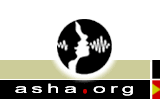
    - - - -
- - - - - - - - - - - -
- - - - - - - -

|
| http://www.asha.org/
Early Hearing Detection and
Intervention Legislation
Where We Are and Why It Matters 
Before recent grassroots initiatives
to mandate infant hearing screening, the average age for
detection of hearing loss among children was 2.5 years. A great deal
of development takes place in those first years of life, and 2.5
years was just too long to wait before initiating detection and
intervention.
ASHA has fought for legislation to provide early
hearing detection and intervention (EHDI) funding and has provided
model legislation for members' use at the state level. The newborn
hearing screening pages on ASHA' s Web site ensure that members and the public have
the latest information, and members and staff have had great success
encouraging newspapers, television, radio, and magazines to cover
the issue. Since last year, PBS' HealthWeek, NBC Nightly
News, the Los Angeles Times, The New York Times, Child
magazine, Parents magazine, and scores of
regional dailies have all covered newborn hearing screening.
Legislative momentum continues to
build on the issue of EHDI, and public awareness is growing about
the impact of hearing loss. It's the stories of the children--real
life examples that cut through all the discussion and debate--that
remind us why this issue is such a priority.
Audiologist Lynn Spivak, who oversees the
screening of more than 22,000 infants per year at the Long Island
Jewish Medical Center, spoke to national news media. She said that
after confirmation of an infant' s hearing loss, the child can be
fitted with a hearing aid at 3 months of age. "By helping the ear
hear properly," Spivak added, "the baby will be feeding the auditory
brainstem with the sounds and information it needs for the child to
grow and learn--and that learning starts at
birth."
< Prev | Next
>
September 5,
2000-adapted
| |
 |
|

